Advertisements
Advertisements
Question
Three light rays red (R), green (G) and blue (B) are incident on a right angled prism ‘abc’ at face ‘ab’. The refractive indices of the material of the prism for red, green and blue wavelengths are 1.39, 1.44 and 1.47 respectively. Out of the three which colour ray will emerge out of face ‘ac’? Justify your answer. Trace the path of these rays after passing through face ‘ab’.
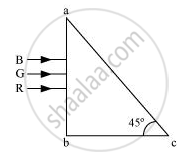
Solution

The blue ray will emerge out of the face ‘ac’.
The three light rays will go through ‘ab’ as the three are perpendicular to ‘ab’. However, when they will hit ‘ac’, they will refract with an angle of incidence of 45°.
Refractive indices for three light rays are given.
Red (R) = 1.39
Green (G) = 1.44
Blue (B) = 1.47
Total internal reflection takes place if the angle of incidence is such that
`sin r>I`
The refractive indices are from air to prism. To convert them from prism to air, we take their reciprocal.
`R = 1/(1.39) = mu_1`
`G = 1/(1.44) =mu_2`
`B1/(1.47) =mu_3`
For red:
`(sini)/(sinr) =mu`
`(sin45)/mu_1 = sinr`
sin r = 0.9828, which is less than 1
Thus, red light will pass through the face ‘ac’.
Similarly, for green:
`sinr = (sin45)/mu_2`
`1.01`
This is greater than 1. Therefore, it will not pass through, but reflect back in the same medium.
For blue:
`sinr = (sin45)/mu_3`
`= 1.039`
Even this will reflect back because of total internal reflection.
APPEARS IN
RELATED QUESTIONS
At what angle should a ray of light be incident on the face of a prism of refracting angle 60° so that it just suffers total internal reflection at the other face? The refractive index of the material of the prism is 1.524.
Three rays (1, 2, 3) of different colours fall normally on one of the sides of an isosceles right angled prism as shown. The refractive index of prism for these rays is 1.39, 1.47 and 1.52 respectively. Find which of these rays get internally reflected and which get only refracted from AC. Trace the paths of rays. Justify your answer with the help of necessary calculations.
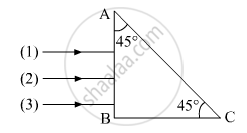
Write the relationship between angle of incidence ‘i’, angle of prism ‘A’ and angle of minimum deviations for a triangular prism.
Trace the path of the ray (P) of light passing through the glass prism as shown in the figure. The prism is made of glass with critical angle ic = 41°.
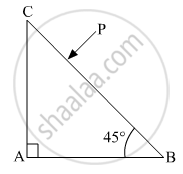
Find the angle of minimum deviation for an equilateral prism made of a material of refractive index 1.732. What is the angle of incidence for this deviation?
Answer the following question.
Calculate the angle of emergence (e) of the ray of light incident normally on the face AC of a glass prism ABC of refractive index `sqrt(3)`. How will the angle of emergence change qualitatively, if the ray of light emerges from the prism into a liquid of refractive index 1.3 instead of air?

The maximum value of the index of refraction of a material of a prism which allows the passage of light through it when the refracting angle of the prism is A is ______.
A ray of light when incident upon a thin prism suffers a minimum deviation of 39°. If the shaded half portion of the prism is removed, then the same ray will ______.
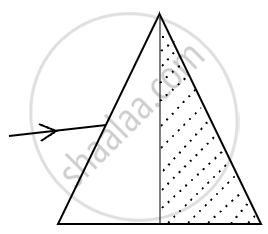
A triangular prism of glass is shown in the figure. A ray incident normally to one face is totally internally reflected. If θ is 45°, then the index of refraction of the glass is ______.
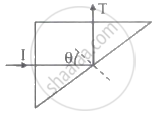
A ray of monochromatic light passes through an equilateral glass prism in such a way that the angle of incidence is equal to the angle of emergence and each of these angles is 3/4 times the angle of the prism. Determine the angle of deviation and the refractive index of the glass prism.
